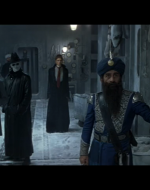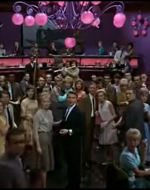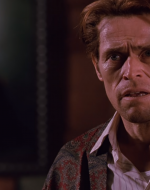Created by Ben Beyer on Mon, 11/21/2022 - 17:08
Description:
Depicting Hyde Through the Gaze of Others
Introduction
Dr. Jekyll and Mr. Hyde has become an essential culture text and common trope in potentially hundreds of different films and pieces of literature. There are a variety of aspects that add to the intrigue of the original story, but the one I’ve chosen to isolate can be summarized by this one quote: “He is not easy to describe. There is something wrong with his appearance; something displeasing, something downright detestable. I never saw a man I so disliked, and yet I scarce know why. He must be deformed somewhere; he gives a strong feeling of deformity, although I couldn’t specify the point. He’s an extraordinary-looking man, and yet I really can name nothing out of the way.” (Stevenson, Pt.1). The appearance and or depiction of Hyde in the different adaptations of the text, while all extremely different, can all in one way or another be drawn back to this single quote. In order to capture the true essence of Hyde, film makers have been required to depict something indescribable, but how could they do such a thing? One potential answer is to focus on the reactions from other characters. “At this point he associated scopophilia with taking other people as objects, subjecting them to a controlling and curious gaze” (Mulvey, 59). Although originally intended to apply scopophilia as a sexual or desirable gaze in the film industry, Mulvey’s words here do speak volumes as to the general desire to stare at another. The love of looking should not be limited to sexual desire, and in the case of an eerie individual such as Hyde, one could consider the curiosity of potential danger to be something that people just can’t take their eyes off of. In each of the films I’ve reviewed I’ve discovered a trend in which the quote from the original text is reflected in how others perceive the Hyde persona, the indescribable nature is spelled all over their faces through varying forms of concern, confusion, intrigue, and fear. Even if their depiction may not align with another, the true essence of Hyde is preserved through the aura and affect he has on those around him.
Image 1: The League of Extraordinary Gentlemen
Norrington, Stephen. The League of Extraordinary Gentlemen. 20th Century Fox, 2003. (00:36:51).
This image was particularly intriguing while exploring the reactions to the various depictions of Hyde. The composition of the image itself has the camera angled slightly more upright than usual in the film, potentially in order to better convey Hyde’s perspective, giving us a more direct view as to what sort of gazes he receives while also conveying the power and dominance he may feel towards those around him. The focal point of the image is also, arguably, Mina, the only female in the room, also giving us a better sense of Hyde’s predatory and sexual nature by being drawn to her. As for the actual reactions to Hyde, they vary slightly but generally show a consistent stunned expression. Similar to how the quote from the original text described Hyde, the individuals in this image sit in stunned silence in observation of Hyde, Billy most of all appears confused and with a lack of understanding. Nemo and Dorian are also outright armed, indicating a natural reaction to be defensive against Hyde. “Well, sir, the two ran into one another naturally enough at the corner; and then came the horrible part of the thing; for the man trampled calmly over the child’s body and left her screaming on the ground. It sounds nothing to hear, but it was hellish to see. It wasn’t like a man; it was like some damned Juggernaut” (Stevenson, Pt.1). This film uses this quote especially when creating their depiction of Hyde, a rampaging monster in essence. This helps to explain the general confusion and fright from the other characters, because this depiction of Hyde focuses on what could be considered more outright wrong with Hyde, thus creating a slightly more intense reaction, while still falling into the general trend of fear and confusion.
Image 2: The Nutty Professor
Lewis, Jerry. The Nutty Professor. Paramount Pictures, 1963. (00:35:31).
The depiction of Hyde in Buddy Love is one of the outliers of the variety I’ve selected, but still consistent in one way or another. Similar to image 1 the camera is set in Buddy’s perspective, looking down on a crowd of people looking back up at him. However, the greater amount of people pausing everything indicates a higher level of presence or dominance for Buddy’s perspective. Placing the audience in this perspective also offers a higher analysis to this image. “Recognition is thus overlaid with mis-recognition: the image recognized is conceived as the reflected body of the self, but its misrecognition as superior projects this body outside itself as an ideal ego, the alienated subject, which, re-introjected as an ego ideal, gives rise to the future generation of identification with others” (Mulvey, 60). Placing the viewer into the main character’s perspective creates this sense of identification with Buddy. This is, of course, particular to the men in the audience who wish to identify with Buddy as the center of attention, the man in charge, a ‘ladies man’. The reactions from the audience also keeps on trend with the reactions to a Hyde figure, stunned silence. Although in this instance it’s meant to be a flip on the narrative of Hyde being hideous to Hyde being very attractive, it still depicts a general confusion and curiosity with his appearance that those staring at him can’t quite understand. Although, in this instance the characters a more consistent curiosity rather than fear given that Buddy is not a physically monstrous individual.
Image 3: Mamoulian’s Dr. Jekyll and Mr. Hyde
Mamoulian, Rouben. Dr. Jekyll and Mr. Hyde. Paramount Pictures, 1931. (00:38:14).
The more interesting factor to be drawn from this image is the actual set this scene takes place on. In comparison to the films generally brighter set pieces, this set in particular with the darker lighting and more run-down appearance to the building connotes a certain danger or lower sense of class to the people in or around the bar. “Atavism, the reversion to a former self, is the first feeble indication of the reaction opposed by nature to the perturbing causes which seek to alter her delicate mechanism” (Ferrero, 160). This article, and this definition, attempt to suggest that human beings revert to a more criminal and animalistic state when put under particular conditions such as the area they live in. Although this is an outdated idea, this scene attempts to act on this idea through the set, suggesting that this area is more dangerous simply through its appearance. The reactions from these particular individuals to Hyde are also rather interesting because their arms are raised and they’re leaning back, or they’re attempting to stay out of his view, suggesting a sort of cowering or fear greater than most of the other reactions we’ve seen to Hyde. Hyde also appears in a more dominant or threatening position through the snarl visible on his face, also slightly suggesting a more animalistic nature. Nonetheless, in this image we have the stunned silence from bystanders to Hyde’s presence, slightly heightened by an added degree of fear, staying in line with the indescribable and eerie nature of the character.
Image 4: Spider-Man’s Green Goblin
Raimi, Sam. Spider-Man. Sony Pictures Releasing, 2002. (01:14:14).
Naturally, in a gallery like this it may have been easier to use the Hulk as a potential comic book character reference. However, the depiction of the Green Goblin in this film is a far more apt representation of the Jekyll and Hyde trope. In essence, Norman Osbourn attempts to create a serum that enhances physical capabilities for a third-party military buyer; however, after taking it himself, the serum alters his mind and creates a separate, vastly more violent and sadistic personality that does not restrain itself to social norms, the Green Goblin. “This familiar that I called out of my own soul, and sent forth to go his good pleasure, was a being inherently malign and villainous; his every thought and act centered on self; drinking pleasure with bestial avidity from any degree of torture to another; relentless like a man of stone” (Stevenson, Pt. 10). This description from Jekyll about Hyde in the original text is very similar to the relationship Norman has with the Goblin, a general fear and apprehension for this villainous side to his nature. This still in particular shows Norman reacting to this new personality. Very different to most of the other depictions of not just Hyde, but Jekyll, Norman and the Goblin actually communicate, so we get a firsthand reaction from the Jekyll persona. Although not very intense, there is some concern and fear evident on Norman’s expression suggesting a bit of unease and confusion by this new discovery. This falls in line with the general trend of unease and confusion caused by the appearance of the Hyde persona, only this time from the perspective of the Jekyll role.
Works Cited
Stevenson, Robert. Strange Case of Dr. Jekyll and Mr. Hyde. Longmans, Green & Co. 1886.
Mulvey, Laura. Visual Pleasure and Narrative Cinema. Screen, Volume 16, Issue 3, 1975.
Ferrero, Gina. “Strange Case of Dr. Jekyll and Mr. Hyde.” “Appendix H: Degeneration and Crime.” Criminal Man According to the Classification of Cesare Lombroso. Broadview Editions, 2015.
Norrington, Stephen. The League of Extraordinary Gentlemen. 20th Century Fox, 2003.
Lewis, Jerry. The Nutty Professor. Paramount Pictures, 1963.
Mamoulian, Rouben. Dr. Jekyll and Mr. Hyde. Paramount Pictures, 1931.
Raimi, Sam. Spider-Man. Sony Pictures Releasing, 2002.





